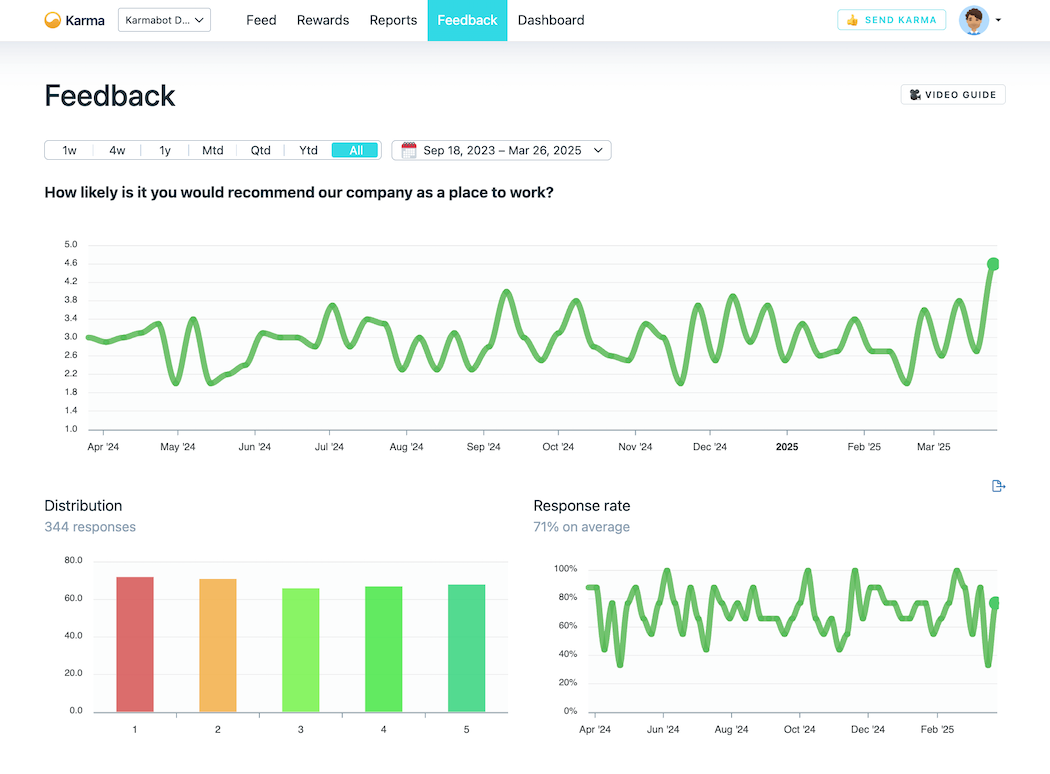Feedback is the backbone of employee recognition. While praise and rewards are essential, recognition without meaningful feedback can feel hollow. Employees don’t just want to hear “good job”—they want to understand what they did well, why it mattered, and how they can continue excelling.
Incorporating constructive, specific, and continuous feedback into your recognition strategy enhances employee engagement, strengthens workplace relationships, and fosters a culture of growth. In this article, we’ll explore how feedback fuels effective recognition, the role of anonymity in honest feedback, and how recognition tools can drive more meaningful workplace appreciation.
Why Feedback is Essential for Employee Recognition
Employee recognition isn’t just about making employees feel good—it’s a strategic tool for boosting motivation, retention, and productivity. Companies that prioritize recognition experience:
- 37% lower absenteeism (Gallup, 2023)
- 31% higher productivity levels (Gallup, 2023)
- 44% higher employee retention (Work Institute, 2023)
However, recognition alone isn’t enough. Feedback ensures that praise is impactful, actionable, and motivational. Here’s why it’s essential:
1. It Makes Recognition More Meaningful
Vague praise like “Great work!” might make an employee smile, but specific feedback creates a lasting impact. Employees want to know what exactly they did well and how it contributed to the company’s success.
For example, instead of saying: “Great job on that project,” try: “Your ability to coordinate with different teams and meet the deadline was impressive. It helped ensure a smooth launch, and the client was thrilled!”
2. It Reinforces Positive Behaviors
Recognition tied to feedback reinforces behaviors that drive results. Employees who receive clear feedback about their strengths are more likely to replicate those actions.
Research from SHRM found that 68% of employees say regular feedback helps them perform better. When recognition includes constructive feedback, employees feel guided and motivated to continue excelling.
3. It Encourages Continuous Improvement
Recognition should celebrate achievements, but it can also highlight areas for growth. Constructive feedback helps employees understand not just their strengths but also where they can improve.
For example, instead of saying: “You handled that customer complaint well,” a manager might say: “You remained calm and professional, which de-escalated the situation. Next time, you could also offer additional solutions to enhance customer satisfaction.”
4. It Strengthens Employee-Manager Relationships
When employees receive recognition accompanied by valuable feedback, they feel seen, heard, and valued. This creates a stronger connection between employees and leadership.
According to Officevibe, 69% of employees say they would work harder if they felt more appreciated by their managers. Recognition with thoughtful feedback fosters trust and a deeper sense of belonging.
The Role of Anonymous Feedback in Employee Recognition
While open feedback is essential, employees sometimes hesitate to give or receive honest recognition due to fear of judgment or bias. This is where anonymous feedback plays a crucial role.
1. Encourages Honest and Constructive Recognition
Employees often feel more comfortable sharing their genuine thoughts when feedback is anonymous. This allows for more balanced, constructive recognition, ensuring that feedback isn’t just positive but also helpful for growth.
2. Gives a Voice to All Employees
Not everyone is comfortable speaking up in meetings or publicly praising colleagues. Anonymous feedback ensures that every team member has a platform to recognize peers without hesitation.
For example, an employee might use anonymous feedback to say: “I really appreciate how Alex always offers to help when workloads are high, even if it’s not their responsibility.”
3. Eliminates Bias in Recognition
Research shows that bias affects workplace recognition, with some employees receiving more acknowledgment than others due to visibility or personal relationships. Anonymity helps level the playing field by ensuring recognition is based on merit rather than favoritism.
4. Provides Insightful Data for Leadership
With anonymous feedback tools like Karma’s feedback feature, leaders gain valuable insights into team dynamics. They can identify patterns in employee engagement, uncover hidden contributions, and make informed decisions about recognition strategies.
Best Practices for Implementing Feedback in Employee Recognition
1. Make Feedback a Habit, Not Just an Event
Recognition and feedback should be ongoing, not occasional. Instead of waiting for annual reviews, create a culture where feedback is a regular part of daily work.
💡 Tip: Use Karma’s recognition platform to send instant feedback and celebrate achievements in real time.
2. Balance Positive Recognition with Constructive Feedback
A healthy feedback culture balances praise with opportunities for growth. Employees should feel encouraged, not criticized.
🔹 Example of balanced feedback: “You did an excellent job leading the presentation! Your confidence and preparation were clear. One area to strengthen is engaging the audience more with questions.”
3. Encourage Peer-to-Peer Recognition
Recognition doesn’t just have to come from leadership. Peer-to-peer recognition is equally important—and often more impactful. Employees feel valued when their efforts are acknowledged by colleagues who directly work with them.
💡 Try this: Use Karma’s anonymous feedback feature to let employees recognize each other’s efforts without fear of judgment.
4. Ensure Feedback is Actionable
Feedback should provide clear next steps. Employees should walk away knowing what they did well and how they can continue improving.
🔹 Instead of: “Great teamwork,” try: “Your collaboration skills really stood out when you helped the team brainstorm solutions. Keep bringing that energy into future projects!”
5. Use Technology to Streamline Recognition and Feedback
Digital recognition platforms like Karma make it easy to integrate real-time recognition, peer feedback, and anonymous input into daily workflows.
✅ Track employee contributions ✅ Enable anonymous peer feedback ✅ Ensure consistent and timely recognition

Final Thoughts: Creating a Culture of Recognition and Feedback
Recognition alone isn’t enough—it needs to be meaningful, specific, and supported by continuous feedback to truly engage employees. When employees receive well-rounded recognition, they feel valued, motivated, and committed to growing within the company.
By incorporating anonymous feedback with tools like Karma, organizations can foster a culture of appreciation that is fair, transparent, and impactful.
Ready to enhance employee recognition with meaningful feedback? Try out Karma for Web with our 30-day free trial


 Why Recognizing Achievements Regularly Is Essential for Team Morale
Why Recognizing Achievements Regularly Is Essential for Team Morale